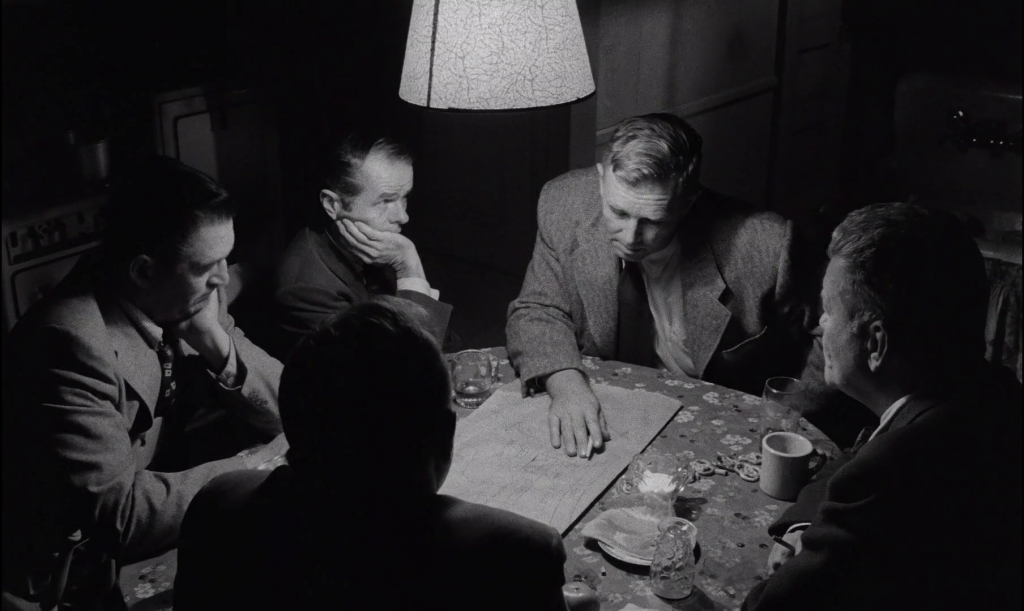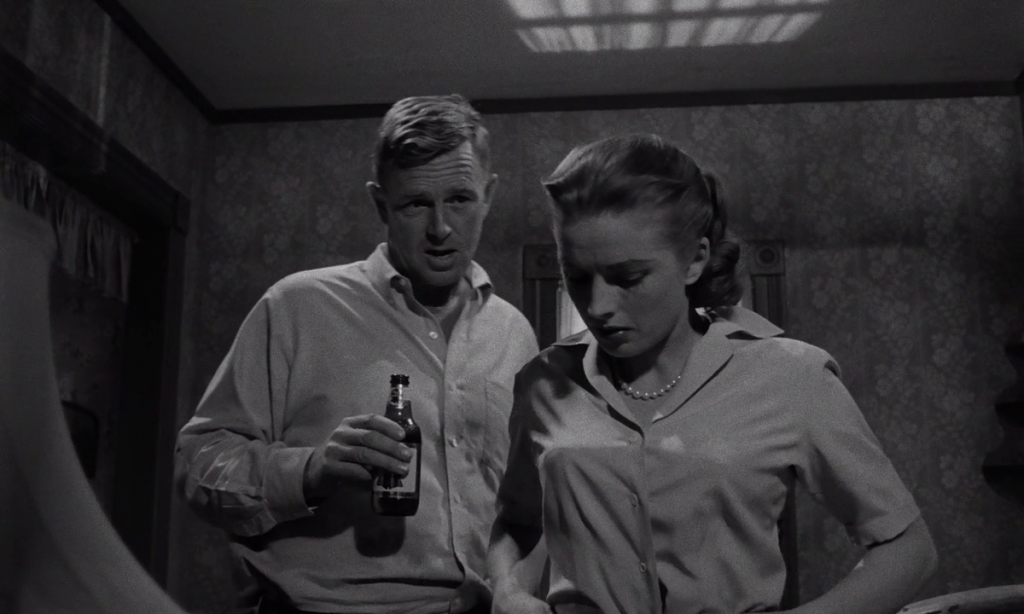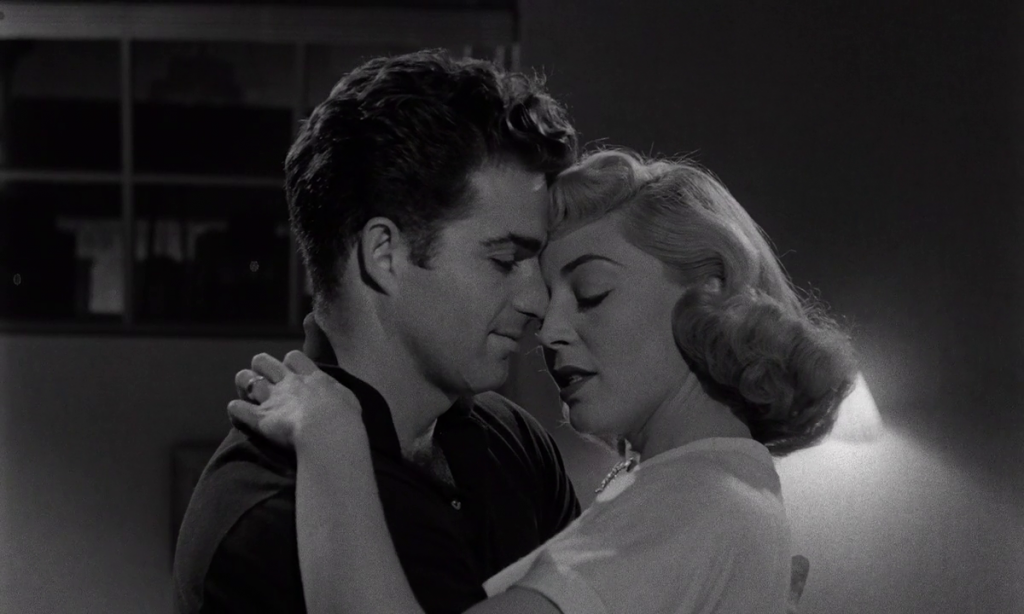
The Conversation is a new feature at Sound on Sight bringing together Drew Morton and Landon Palmer in a passionate debate about cinema new and old. For their second piece, they will discuss Stanley Kubrick’s film The Killing (1956).
Drew’s Take
Stanley Kubrick’s The Killing (1956) is not my favorite work by the visionary director. In fact, the film probably wouldn’t even make it onto a list of my top five Kubrick films. Yet, with a career that included such amazing films as Paths of Glory (1957),Dr. Strangelove or: How I Learned to Stop Worrying and Love the Bomb (1964),2001: A Space Odyssey (1968), Barry Lyndon (1975), and The Shining (1980), that’s not an indication that The Killing is a film of poor quality but an indication that Kubrick’s body of work comes the closest to cinematic perfection than any director I can think of. Thus, while The Killing may not by Kubrick’s strongest, that doesn’t keep it from earning a position in a ranking of my top five noirs.
The film was adapted from a novel by a prominent hardboiled author (Lionel White, whose novel Obsession was adapted by Jean-Luc Godard as Pierrot le Fou) by a fellow colleague (Jim Thompson, author of The Grifters and A Hell of a Woman, which was adapted into one of my favorite neo-noirs, Série Noire). Perhaps due to the presence of these two hardboiled authors, casual but knowledgeable viewers of the noir genre might feel that the plot of The Killing is fairly stereotypical. After all, the film covers the meticulous planned robbery of a racetrack, masterminded by veteran criminal Johnny Clay (Sterling Hayden). On the surface, the plot is strongly reminiscent of John Huston’s The Asphalt Jungle (1950) which also stars Hayden. Yet, as Kubrick and noir scholar James Naremore notes in his book length study on the director, Kubrick was drawn to the novel precisely because he held affection for Huston and his film. In fact, the reason why The Killing is such a fascinating noir is that it capitalizes on a familiar plot in order to direct our attention elsewhere.
The bulk of the film revolves around Clay and his band of outsiders, which includes a corrupt cop (Ted de Corsia), a sharpshooter (Timothy Carey), a bartender (Joe Sawyer) and George Peatty (Elisha Cook Jr.), a payout clerk at the track. The genius of the plan lies in the fact that the payout is huge (“They can put you away just as fast for a $10 heist as they can for a million dollar job.”) and that none of the men are traditional criminals (but “they’ve all got a little larceny in ’em.”), so they’re not, to borrow the title from Bryan Singer’s film, the usual suspects. Yet, the fabric of Clay’s painstaking plan begins to fray when George lets it slip to his unfaithful wife Sherry (Marie Windsor), who has “a great big dollar sign there where most women have a heart.” Sherry isn’t happy with George’s cut of the potential two million dollars and begins devising a way to make off with the entire take. As I said, it’s not the most original plot, but Kubrick utilizes its conventionality to experiment with film form in order to drive home one of themes that lies at the heart of the noir genre: existentialism.

Kubrick amplifies this existentialism by using both the plot and film form to undermine the meticulous heist that Clay has devised. In terms of the narrative, Clay’s plan appears flawless. He has assembled a competent team, every consideration has been made regarding each individual’s alibi, and he even realizes the potential of Sherry’s betrayal rather early in the plot. Yet, the plot begins to break down due to acts of God: a traffic jam, a misplaced horseshoe, a faulty suitcase, and a small dog. As George notes in the aftermath of the heist, “Everything else runs on a timetable ’til it comes to payin’ us our shares. Then the timetable breaks down.” In the end, faced with a cosmic vengeance matched only by Huston’s The Treasure of the Sierra Madre (1948), even Clay reaches the realization that fate is both inescapable and indifferent to human endeavor. As he states in a dialogue with his girlfriend Fay (Coleen Gray):
FAY: Johnny, you’ve got to run.
JOHNNY: Nah. What’s the difference?
With regard to film form, the film’s emphasis of existentialism comes from two factors. First, Kubrick’s camera style makes use of a 25mm, wide-angle lens that often makes sweeping lateral movements through the cramped spaces of the film, often gliding where walls would traditionally stand. The wide-angle lens, presenting us with deep focus imagery from impossible to reach spaces – Godlike – presents us with a seemingly omnipresent point-of-view, which Kubrick further emphasizes in his narrative structure. The structure of the film is shuffled chronologically (Quentin Tarantino later cited the film as an influence on his time-bending structure) and Kubrick places of a narrator on the film’s soundtrack. The narrator speaks to us in the past tense and, due to his overwhelming guidance and authority over the timeline, the viewer perceives that he is both truthful and omniscient. Yet, for those viewers paying attention, the narrator not only leaves out a key plot development but also makes several errors in describing the chronology of events. The omniscience of the narrator begins to disintegrate through its distortion…just as a wide-angle lens will subtly warp space.
While one of my favorite aspects of The Killing is its use of a well-treaded plot in service of a deeper examination of existentialism, Kubrick also utilizes the plot to examine sexual and racial issues as well. The film’s investigation of sexuality primarily arises from two relationships: between Marvin (Jay C. Flippen) and Clay and between Sherry and George. The first relationship is less substantial, as homosexuality could only be implied at the time. Marvin expresses a not too subtle longing to be with Clay. Flippen’s eyes glimmer when Clay compliments his involvement and responds, “Wish I could do more.” Later in the film, Marvin tries to talk Clay out of his marriage so that “we could go away, the two of us, and let the old world take a couple of turns.” Scorned, Marvin shows up at the track during the heist and drinks himself into a stupor, a potential obstacle for the team to overcome. As noted, it is not a terribly deep examination – albeit a bit more than Joseph H. Lewis’s The Big Combo (1955), but it hints at a profound loss and heartbreak.
The second, on the other hand, is one of the focal points of the film as we watch Sherry’s femme fatale continually manipulate the impotent George for 90 minutes. As she tells him, “I never had anybody. Not a real husband, just a bad joke without a punchline.” The only way George can assert his power and sexuality is through violence, a scathing view of masculinity. Thanks in large part to the performances of dominating and sexy Windsor and bumbling Cook, the domestic jockeying between the married couple is one of the highlights of the film. Sherry repeatedly acknowledges that her proper place in the home would be within a traditional gender role (preparing food, bowing to the dominance of George) by undermining and rubbing George’s face in it.
SHERRY: You want me to cal you poppa. Isn’t that it? And you’d call me momma?
GEORGE: You know all the answers.
SHERRY: Go ahead. It may be your last word, but I’ll try to kill you painlessly.
[…]
GEORGE: I don’t suppose there’s anything for dinner.
SHERRY: Of course there is. There are all sorts of things.
GEORGE: I don’t smell nothin’.
SHERRY: That figures. You’re too far away from it….You don’t think I had it cooked, do you? It’s down at the shopping center.
The racial subtext comes across in an interaction between Timothy Carey’s teeth-clenching, scenery chewing sharpshooter and a black parking attendant whom, according to Naremore, we are encouraged to feel both sympathy and animosity towards. I would tend to agree. The parking attendant is a kind man who blossoms under the warmth of Carey’s respect. Yet, as the sequence progresses, he also becomes a narrative obstacle – a nuisance threatening the heist – and our empathy gradually mirrors Carey’s frustration. While the film’s examination of sexuality and race are left vaguely defined in comparison with its realization of existentialism, I admire the film for providing the viewer with much to digest within the shell of a straight-forward genre picture.

Landon’s Take
It’s difficult to see The Killing outside of a greater evolutionary arc of Stanley Kubrick’s subsequent career, especially since it looks and feels in many ways like a developmental text for a burgeoning cinematic artist. Simply put, Kubrick’s first Hollywood-ish (read: United Artists) production – a $320K B-movie he made after two bona-fide indies, the dynamic Killer’s Kiss (1955) and the underrated Fear and Desire (1953) – seems inevitably small on first glance for a viewer who has come to it after basking in the epic scale and visionary perfectionism of 2001: A Space Odyssey, Barry Lyndon (1975), and The Shining. Yet there are definite ties to the rest of Kubrick’s work, from the inventive sideways tracking shots that fluidly move through walls to Sterling Hayden’s early invocation of the “Kubrick stare.” In fact, Hayden’s Johnny Clay is as much of an obsessive male subject to his own self-destructive tunnel vision as the leads of Lolita (1962), The Shining, and Eyes Wide Shut (1999). With The Killing, Kubrick tapped into a fascinating rupture in the visage of Hayden’s rugged masculine exterior that the director would soon use to illustrate confident, unassuming mania in his role as the fluid-obsessed brigadier general in Dr. Strangelove. When Hayden/Johnny dons that clown mask during the robbery, The Killing automatically joins Kubrick’s pantheon of striking cinematic icons.
There are more than plenty of Kubrickian breadcrumbs littered throughout The Killing for the auteurist cinephile to follow towards a vision of the director’s defining style, themes, and worldview. Drew has expertly covered many aspects of this film that carry over into Kubrick’s other work – from a portrayals of male sexual crisis and homoeroticism within homosociality that the director pursued in various capacities throughout subsequent titles like Spartacus (1960) and A Clockwork Orange (1971) to Kubrick’s larger practice of representing a character’s psychological state via a detailed attention to film form – while situating the film historically within a Hollywood tradition of interconnections between theme and genre. With that groundwork established, I’d like to explore one thing that I’ve always found to be uniquely compelling about this particular entry of Kubrick’s arsenal, especially as an early, arguably “transitional” entry in the director’s larger career: that is, how strangely the film functions out of step with Hollywood conventions of storytelling while at the same bearing the sheen of a glorious “lack” of polish that does not match the perfectionism with which the director later sealed his reputation.

The look and feel of much of The Killing greater resembles Kubrick’s photography for Life magazine and other glossy outlets during the midcentury. In contrast to the almost mathematic formal precision characteristic of the director’s best-known films, Kubrick’s photography shows a keen eye for evocative composition and framing, but also produces the feeling of a moment captured within an otherwise frantic and fast-paced world – tonally, as far as you can get from the elegant tableaux of Barry Lyndon. Essential to this impression is the image of New York City under Kubrick’s eye, which captures a manic sleeplessness that bears a treasure trove of strange beauty for the discerning, instinctive onlooker. In Killer’s Kiss, made a year before The Killing, Kubrick translates this sensibility effectively to the moving image by utilizing a handheld 16mm camera that maneuvers around a NYC boxing match with palpable speed and immediacy, inadvertently producing a fiction form of cinéma vérité before the fact. As far as location shooting goes, Kubrick’s 1950s New York is more John Cassavetes than Jules Dassin.
While the greater resources under the auspices of producer James B. Harris afforded Kubrick the benefit of tracks in order to realize an altogether different mode of mobile photography in the aforementioned room-hopping tracking shots, much of the raw sensibility that Kubrick displayed in his previous work is still evident in The Killing. The newsreel-style footage of the horse racetracks (used no fewer than three times throughout, including the opening credits) both imbue the film with a sense of vérité realism and emphasize the film’s unusual, circular, non-linear (and, as Drew points out, deliberately confused) timeline. One of my favorite moments of The Killing, and perhaps one of the stranger moments in the entire Kubrick canon, features Johnny’s confidant Maurice (Georgian-American professional wrestler Kola Kwariani) staging a fight in order to distract the track’s police force from Johnny’s heist. The hard-boiled pragmatism of the film’s expedient and economic B-movie pacing suddenly gives way to the strange spectacle of what can most accurately be described as an onscreen wrestling match in which Maurice fends off multiple policemen with a string of flamboyant maneuvers, at times sped up to increase the sense of action.
The compact shooting schedule that was no doubt required of such an economically executed production ends up benefitting The Killing greatly, making it an utterly unique text amongst both Kubrick’s career and Hollywood noir. It contains neither the strictly executed ambition of Kubrick’s work from the late-60s onward nor the A-movie sheen of the contemporary Asphalt Jungle. Instead, the instinctual shooting methods Kubrick learned as a photographer and independent filmmaker here meets the shared bottom lines and relative freedom within B-level Hollywood filmmaking. This peculiar alchemy imbues The Killing with a sense of restless energy that is difficult to find in Kubrick’s later work, and this energy is what makes the film’s final moments – in which all of the third act’s compounding unanticipated factors lead to an instance of literal release as Johnny’s bag of money breaks wide open for the world to see, his face shocked and yet somehow resigned – such an effective build of suspense. Kubrick was a master at depicting worlds (and people) out of control, but none of his films took advantage of a variegated approach to form in order to play so wildly with this idea quite like The Killing.


